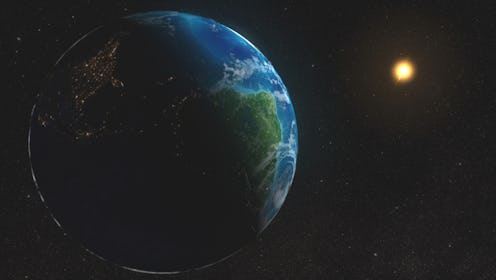News
Earth's Latest Selfie Is Stunning

If the planets had their own Instagrams, none of us would ever want to snap a selfie again, for fear of looking weak in comparison. Just take the latest photo of our own planet Earth — the first full, sunlit-side photo since Apollo 17 first captured the famous blue image way back in 1972. If this photo were an Instagram post on Terra's (that's Earth's official name) feed, it would have 7.1 billion likes and a comment from Jupiter that simply read, "Girrrrrl." In all seriousness, however, the new picture is pretty amazing for several reasons other than it just being terrifically stunning.
Taken by the Deep Space Climate Observatory (DSCOVR), which was launched back in February by the brainiacs at NASA, the National Oceanographic and Atmospheric Administration (NOAA), and the U.S. Air Force, at just over 1 million kilometers from Earth (that's around 930,000 miles), the photograph has surpassed all expectations and made an immediate impression with not only the climate scientists behind the DSCOVR spacecraft project, but the Commander-in-Chief himself.
"Just got this new blue marble photo from @NASA," tweeted President Obama on Monday. "A beautiful reminder that we need to protect the only planet we have."
The primary concern of DSCOVR scientists, of course, wasn't just to capture a gorgeous photo: The team is now looking into data regarding solar winds, which provide an "early warning" of impending magnetic storms that could potentially wreak havoc on Earth's electrical grid. In layman's terms, researchers are working on an alarm system meant to alert scientists when a particularly powerful storm is headed toward us — and according to NASA spokesman Steve Cole, there's still a lot more information (and even more beautiful imagery) on its way that will help.
"This [new image] is the first of what will be a long-term, daily stream of images of Earth NASA will start delivering to the world starting in September," Cole tells Bustle. "About a dozen pictures a day ... that's never been done before."
Additionally, the image is the first un-stitched image of our home planet taken in over four decades (most images of Earth are composite photos linked up to create one full-sized picture).
"The color images of Earth from NASA’s Earth Polychromatic Imaging Camera (EPIC) are generated by combining three separate images to create a photographic-quality image," explained a NASA spokesperson in a statement on Monday. "... The EPIC team now is working on a rendering of these images that emphasizes land features and removes this atmospheric effect."
But while scientific data is important, it's still alright to want to just sit back and admire the amazing "blue marble" (as well as the recent photos of Pluto taken by the New Horizons team) — the astronauts like to do it too. Cole explains in an email to Bustle:
I had the privilege of being with the New Horizons team when they got their first look at Pluto close-up last Tuesday morning. Imagine: the first view of a strange world! They were pointing out cool features left and right -- as excited as kids!
Seeing Earth is a different kind of thrill. Is there a more beautiful planet, really? But this image is only one of many ways NASA shows us our home in anew with over a dozen satellites. The thrill of how NASA looks at the Earth is imagining that with these multifaceted views — most zipping around the planet 24/7 — we are getting to see how a living planet works. The whole thing! And to tease out what impact humans have on a whole planet!
Think about that. It's outrageous! NASA is doing that.
Still not convinced of just how momentous the recent snapshot really is? Take it from one of the few men lucky enough to see it with his own eyes, directly from space.
"As a former astronaut who's been privileged to view the Earth from orbit, I want everyone to be able to see and appreciate our planet as an integrated, interacting system," said NASA Administrator Charlie Bolden, in a statement on Monday. "DSCOVR's observations of Earth ... will help every person to monitor the ever-changing Earth, and to understand how our planet fits into its neighborhood in the solar system."
How's that for an amazing selfie?